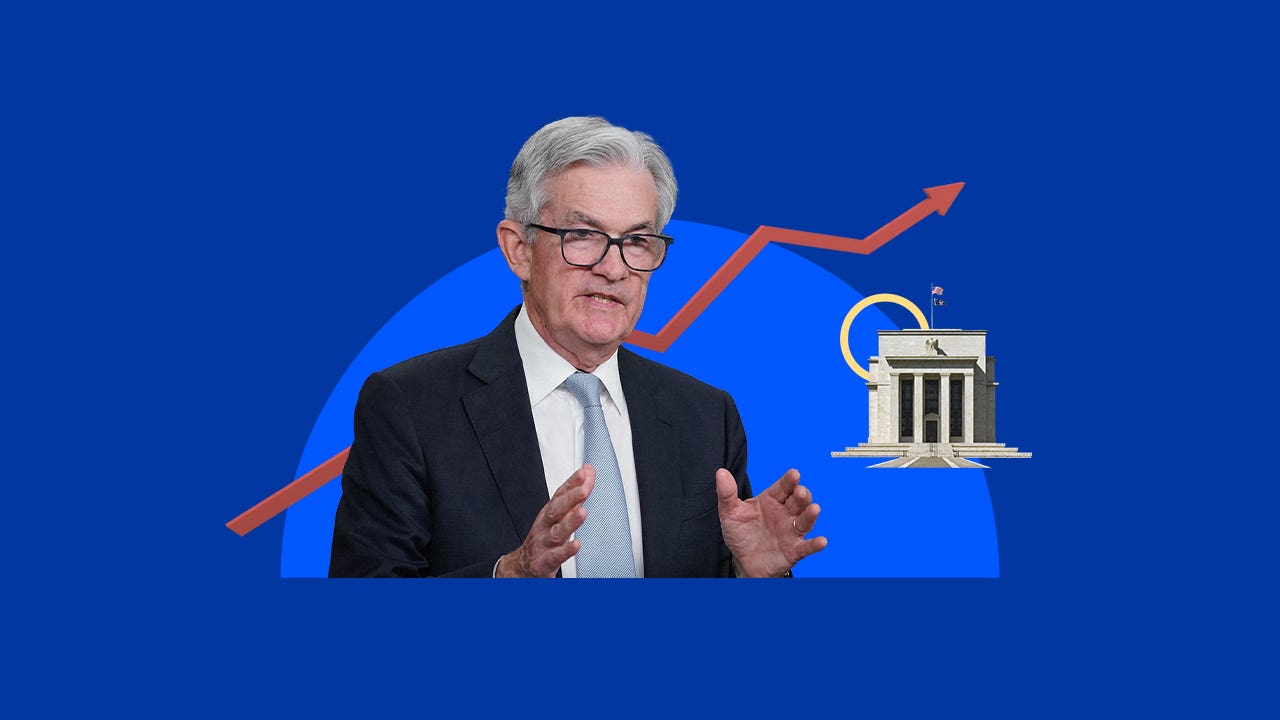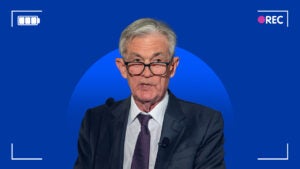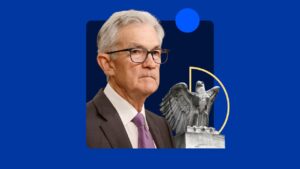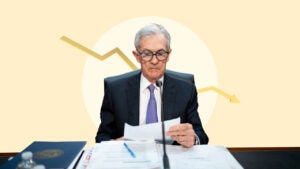Preview of the June Fed meeting: 3 key themes to watch as the economy slows but interest rate cuts remain delayed

Key takeaways
- The FOMC is expected to leave interest rates at a 23-year high at their upcoming meeting, and their estimates of three rate cuts for 2024 may be revised to show fewer cuts, or potentially none at all.
- The reason for rate cuts will be more important than the timing, with a gradual slowdown in the economy being a preferred scenario.
- Consumers should focus on paying off high-interest debt and building an emergency fund.
Federal Reserve officials may have unintentionally compared themselves to airline pilots when they first began raising interest rates at the fastest pace in 40 years, aspiring to “softly land” the U.S. economy by gradually slowing growth.
But as hot inflation keeps forcing policymakers to delay rate cuts, the metaphor continues to be the best way to describe what’s happening to the U.S. central bank — especially now that officials and interest rates seem to be stuck in a holding pattern.
At their next gathering in June, the Federal Open Market Committee (FOMC) is expected to leave borrowing costs at a 23-year high of 5.25-5.5 percent, where their key benchmark rate has held since July 2023.
Rates are imitating reality: Just as it’s almost been a full year since the Fed last touched interest rates, price pressures also haven’t improved for almost 12 consecutive months. Inflation hit a two-year low of 3 percent in June 2023 and has since bounced higher, touching 3.4 percent most recently in April. A new report due the same day as the Fed’s rate decision could show that the stubbornness continues.
Thanks to those inflation surprises, officials have had to tweak their rate plans the same way captains adjust their flight paths. When the year first began, most economists debated whether the Fed would begin cutting interest rates by their June or July meetings given the rapid slowdown in inflation. Today, they debate whether officials are even going to reduce interest rates at all. That’s even as some of the Fed’s foreign counterparts — at the Bank of Canada and European Central Bank — are already kick-starting the easing process with rate cuts.
Unchanged rates mean the takeaways for consumers remain the same. Financing rates on loans and credit cards are likely to stay high, underscoring the importance of paying down high-cost debt, while savers still have time to reap the benefits of the highest yields in over a decade.
Inflation may not be coming down as fast as we’d like, but the economy has not deteriorated as had been expected. I think we’d take that over the alternative: inflation returning to 2 percent, lickity split, but of course, the economy rolling over.— Greg McBride, CFA , chief financial analyst for Bankrate
1. The Fed will most likely have fewer rate cuts for 2024 penciled in — if at all
The most notable part of the Fed’s upcoming meeting isn’t going to be what officials do with interest rates — but what they say about them.
Policymakers are expected to update consumers and investors on their expectations for the economy, growth, unemployment, inflation and interest rates over the year ahead with a refresh of their scrutinized Summary of Economic Projections (SEP).
The last time officials updated those estimates, Fed policymakers’ median estimate suggested that three rate cuts for 2024 were penciled in — a reality that is unlikely to still be the case, for reasons even simpler than stubborn inflation: math.
After the Fed’s upcoming June announcement, officials will have only four rate-setting meetings left. Economists say rapid-fire rate cuts likely aren’t necessary in an era when economic growth is still resilient and inflation is elevated. In other words, three rate cuts at four meetings might give off the impression that Fed policymakers think they need to rush to ease.
“The economy has, more often than not, surprised to the upside over the last few years,” McBride says. “There isn’t necessarily a lot of compelling evidence right now that we’re on the cusp of anything more than just a slower pace of economic growth.”
A dovish update would signal that two cuts remain on the table for 2024. Yet, estimates for just one — or even no cuts — would be considered more hawkish.
“Our expectation is that the first rate cut occurs in the third quarter,” says Invesco’s Global Market Strategist Kristina Hooper, who expects that estimates will now show two cuts in 2024. “September seems more likely than July, but I still hold out hope that July is on the table.”
2. Why the Fed cuts rates may be more important than when
But while most investors and consumers seem hyper-focused on the timing of rate cuts, even more important will be the reason for them.
The best-case scenario continues to be that inflation glides back toward the Fed’s 2 percent goalpost without denting the job market, prompting Fed officials to gradually begin lowering interest rates. But a more worrisome reason to cut interest rates would be a deteriorating economy.
Notably, Fed officials acknowledged at their previous rate-setting gathering in May that they considered a slowdown in the job market enough of a reason to cut interest rates, too — even if price pressures are still higher than they’d like.
“I think there’s also other paths that the economy could take, which, which would cause us
to want to consider rate cuts,” Powell said at the post-meeting press conference. “Two of those paths would be that we do gain greater confidence, as we’ve said, that inflation is moving sustainably down to 2 percent, and another path could be an unexpected weakening in the labor market.”
Even though growth looks resilient, economists can cherry pick reasons to be concerned.
Data from the Department of Labor shows a rapid 8 percent drop in job openings so far this year, and the ratio of job openings per every unemployed worker has fallen back to pre-pandemic levels.
Another worrying sign, unemployment recently hit a more than two-year high of 4 percent in May, bringing joblessness’ streak of holding below 4 percent for the longest stretch of time since the 1960s to an end.
Even so, hiring remains historically robust and unemployment is still at a historic low. The Fed’s estimates of the longer-run unemployment rate — often considered the natural level, or “full” employment — is 4.1 percent. Not to mention, a cooldown in the economy is something the Fed is intending to engineer with higher interest rates, a price they see as worth paying to cool inflation.
Yet, the longer interest rates stay high, the greater the pressure it exerts on the U.S. financial system. An estimate from the San Francisco Fed puts the inflation-adjusted benchmark federal funds rate at 6.27 percent, the highest in estimates dating back to 2009.
“The labor market appears to be roughly in equilibrium, but the Fed needs to walk a tightrope,” says Ryan Sweet, chief economist at Oxford Economics. “If they wait for concrete evidence that the labor market is bending, then it’s too late.”
The latest remarks on interest rates and the economy from the Fed officials
I was on the record before saying I was at the median, which was three. The developments I’ve seen in the economy right now, I would not think that that’s still appropriate.— Loretta Mester, Cleveland Fed President
I want to get all the data I can get before the next FOMC meeting before I reach any conclusions, but I can tell you this, it certainly won’t be more than two cuts.— Neel Kashkari, Minneapolis Fed President
It’s just too early to think about cutting rates. I need to see some of these uncertainties resolved about the path that we’re on.— Lorie Logan, Dallas Fed President
With consumers and businesses alike sheltered from higher interest rates thanks to pandemic-era debt paydowns and refinancing, their aggregate interest burden is not yet historically elevated. To me, that suggests the full impact of higher rates is yet to come.— Thomas Barkin, Richmond Fed President:
3. It’s getting harder to know the difference between a normalizing economy and a recession-prone economy
The U.S. economy’s gangbusters post-pandemic boom was never expected — or supposed — to last forever. Workers had the best bargaining power in years to job hop and ask for higher pay. But it came with a price: The hottest inflation in decades.
“The deceleration in the economy seems orderly, but it still can be uncomfortable,” Sweet says.
Fed officials have been intending to let some air out of the balloon to defeat inflation, even if they don’t want too much to escape. Yet, economists and Fed officials themselves may find it difficult to determine whether the slowdown is healthy — or more worrisome.
Take Chicago Fed President Austan Goolsbee, for example. In response to a question from Bankrate about rising consumer loan delinquency rates, the Fed official said that while the level isn’t concerning, the rate of change is.
“If the delinquency rate of consumer loans starts rising, that is often a leading indicator for, ‘things are about to get worse,’” Goolsbee said at a panel hosted by the Society for Advancing Business Editing and Writing (SABEW). “If I just told you the level, and you compared that to pre-Covid, it doesn’t look that different.”
The same logic could apply for the unemployment rate. Since 2000, joblessness has averaged 5.7 percent, even holding above 6 percent without the economy being in a recession. If joblessness were to hit 4.5 percent, it might not be considered historically high — though the slowdown is undeniable when compared to its previous half-century low of 3.4 percent
“A half percentage point increase from what was a 50-plus year low, is that something to worry about?” McBride says. “It’s a hard argument to make when unemployment is 4%. It would be a hard argument to make if unemployment were 4.5%.”
What the Fed’s next announcement means for you
Higher rates for longer means consumers need to devise a plan for paying off any high-interest debt and building an emergency fund so they’re well-prepared for any unexpected expense.
- Banks are still offering the best returns on consumers’ deposits in over a decade. The top-yielding online bank is currently offering a 5.55 percent annual percentage yield (APY), Bankrate’s latest rankings show. An added bonus of a high yield is that it can help you grow the funds you use for unexpected expenses or longer-team goals even quicker. At these current levels, a 5.55 percent APY could generate $555 in interest in one year on a $10,000 deposit.
- Customers still have the opportunity to lock in those higher yields for the long term through a certificate of deposit (CD). Yields on 5- and 1-year CDs were falling fast as it looked like the Fed was about to cut interest rates. They’ve now since stabilized, and most important for consumers, are continuing to top inflation. The best 1-year CD can lock in a 5.36 percent APY, while 5-year CDs are currently paying a top yield of 4.55 percent. If you’re fine with locking away the funds, those yields could help make sure you’re still earning a decade-smashing yield, even if rates do eventually begin to drift lower.
- A significant accelerator for your debt repayment plan are balance-transfer cards, which currently offer up to a 0 percent introductory annual percentage rate (APR) for around 21 months, according to Bankrate’s latest findings. Meanwhile, the 30-year fixed-rate mortgage is unlikely to fall materially without greater evidence of a slowdown in inflation. Even if the Fed cuts interest rates two times, borrowing costs are expected to hold at the highest levels in over a decade, Bankrate’s 2024 forecast shows.
“Rates aren’t going to come down soon enough or fast enough to bail you out,” McBride says. “As a borrower, you’re going to have to do the heavy lifting of paying down debt.”






